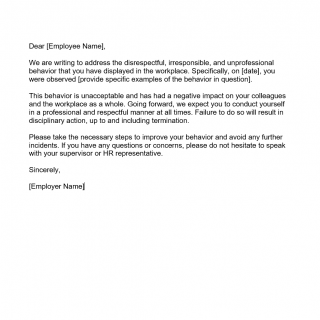Warning Letter to Employee for Unacceptable Behaviour
A warning letter to an employee for unacceptable behavior is a formal document used by employers to address and correct instances of disrespectful, irresponsible, and unprofessional conduct by an employee. The main purpose of this letter is to communicate to the employee that their behavior is unacceptable, and to provide clear expectations for future conduct.
The letter should start with a clear statement of the unacceptable behavior, followed by a description of the impact of the behavior on the workplace or colleagues. It should also include a statement of the expected behavior going forward, as well as a timeline for improvement. It is important to include specific examples of the behavior in question, as well as any relevant policies or guidelines that have been violated.
The parties involved in the letter are the employer and the employee. It is important to consider the legal implications of the letter, as well as any potential consequences for the employee, such as disciplinary action or termination. The letter should be signed by the employer and the employee, and a copy should be kept in the employee's personnel file.
Important fields to include in the letter are the employee's name, job title, and department, as well as the date and location of the behavior in question. It is also important to include a clear statement of the consequences for continued unacceptable behavior.
When compiling the letter, the employer will need to gather evidence of the unacceptable behavior, such as witness statements or documentation of the behavior. It may also be helpful to consult with HR or legal counsel to ensure that the letter is legally sound and aligned with company policies.
Application examples and use cases for the letter include addressing instances of harassment, discrimination, or other forms of workplace misconduct. The letter can also be used to address performance or conduct issues that are not severe enough to warrant termination.
Warning Letter to Employee for Unacceptable Behaviour sample
Dear [Employee Name],
We are writing to address the disrespectful, irresponsible, and unprofessional behavior that you have displayed in the workplace. Specifically, on [date], you were observed [provide specific examples of the behavior in question].
This behavior is unacceptable and has had a negative impact on your colleagues and the workplace as a whole. Going forward, we expect you to conduct yourself in a professional and respectful manner at all times. Failure to do so will result in disciplinary action, up to and including termination.
Please take the necessary steps to improve your behavior and avoid any further incidents. If you have any questions or concerns, please do not hesitate to speak with your supervisor or HR representative.
Sincerely,
[Employer Name]
Strengths of the letter include its ability to clearly communicate expectations and consequences, and to provide a formal record of the behavior in question. Weaknesses include the potential for the letter to damage the employer-employee relationship, and the risk of legal action if the letter is not carefully worded. Opportunities include the potential for the letter to improve workplace culture and productivity, while threats include the potential for the letter to create a hostile work environment.
Related forms may include performance improvement plans, termination letters, or other disciplinary actions. The main difference between these forms and the warning letter is the severity of the consequences.
Overall, the warning letter to an employee for unacceptable behavior is an important tool for employers to address and correct instances of misconduct in the workplace. By clearly communicating expectations and consequences, employers can improve workplace culture and productivity, while also protecting themselves from legal action. The letter should be submitted to the employee in person, and a copy should be kept in their personnel file for future reference.

